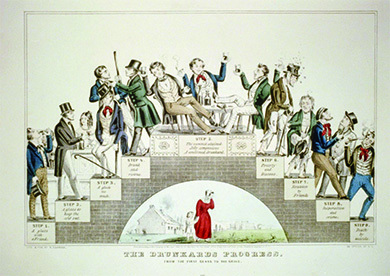| << Chapter < Page | Chapter >> Page > |
Antebellum reform efforts aimed at perfecting the spiritual and social worlds of individuals, and as an outgrowth of those concerns, some reformers moved in the direction of ensuring the health of American citizens. Many Americans viewed drunkenness as a major national problem, and the battle against alcohol and the many problems associated with it led many to join the temperance movement. Other reformers offered plans to increase physical well-being, instituting plans designed to restore vigor. Still others celebrated new sciences that would unlock the mysteries of human behavior and, by doing so, advance American civilization.
According to many antebellum reformers, intemperance (drunkenness) stood as the most troubling problem in the United States, one that eroded morality, Christianity, and played a starring role in corrupting American democracy. Americans consumed huge quantities of liquor in the early 1800s, including gin, whiskey, rum, and brandy. Indeed, scholars agree that the rate of consumption of these drinks during the first three decades of the 1800s reached levels that have never been equaled in American history.
A variety of reformers created organizations devoted to temperance , that is, moderation or self-restraint. Each of these organizations had its own distinct orientation and target audience. The earliest ones were formed in the 1810s in New England. The Massachusetts Society for the Suppression of Intemperance and the Connecticut Society for the Reformation of Morals were both formed in 1813. Protestant ministers led both organizations, which enjoyed support from New Englanders who clung to the ideals of the Federalist Party and later the Whigs. These early temperance societies called on individuals to lead pious lives and avoid sin, including the sin of overindulging in alcohol. They called not for the eradication of drinking but for a more restrained and genteel style of imbibing.
This 1840 temperance illustration ( [link] ) charts the path of destruction for those who drink. The step-by-step progression reads:
Step 1. A glass with a friend.
Step 2. A glass to keep the cold out.
Step 3. A glass too much.
Step 4. Drunk and riotous.
Step 5. The summit attained. Jolly companions. A confirmed drunkard.
Step 6. Poverty and disease.
Step 7. Forsaken by Friends.
Step 8. Desperation and crime.
Step 9. Death by suicide.

Who do you think was the intended audience for this engraving? How do you think different audiences (children, drinkers, nondrinkers) would react to the story it tells? Do you think it is an effective piece of propaganda? Why or why not?

Notification Switch
Would you like to follow the 'U.s. history' conversation and receive update notifications?